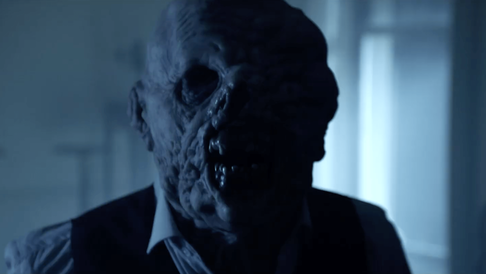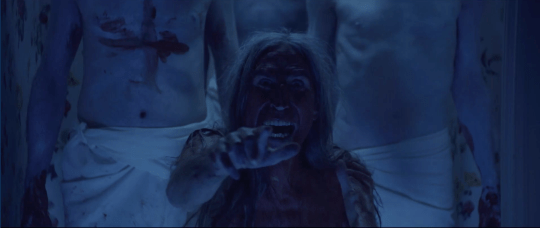 Let me describe a movie and see if you can guess which film I am talking about. An estranged or distant family member inherits a house (or returns home after many years away) only to find the relatives who previously owned the house held a secret. As the heroes dig deeper and deeper into the mystery surrounding their new home, the supernatural occurrences within the house grow increasingly spookier and more deadly... ...Perhaps the uneasiness originally starts with creaking steps, doors slowly opening on their own, and empty rocking chairs doing what they do best. Eventually a hidden document or toy becomes discovered and the protagonists uncover unsettling news about the past. Which film am I describing? Castle Freak? The Awakening? The Orphanage? We have heard the story over and over again, but do not assume this familiar plot has nothing new to offer. Sometimes it takes a newcomer to find a different approach to the same old stories. Charlie Steeds works as the director, writer, and producer for An English Haunting and even though his film experience would label him as a newbie, he finds a way to stray enough from the standard horror tropes to make his haunted house story unique. First, let’s fill in more details from the previously mentioned plot points, so we can all better understand the story. The comatose and dying Aubrey Clemonte (Barrington De La Roche) becomes locked away in the attic of his massive house as his sickness and creepiness unsettle most people. However, he still needs a caretaker, so his housekeeper, Marian Clark (Emma Spurgin Hussey) looks for help. Miss Clark pleads for the family to show compassion for Audrey in his final days, but after the nurse unexpectedly flees the home, the dying man’s estranged daughter becomes the only option. Margot Clemonte (Tessa Wood) could not be described as compassionate and she stresses her distaste for her father with almost every breath. Her adult son presents a slightly softer approach to the situation, but still, his attention to his grandfather stems more from curiosity than care. Despite not having seen his grandfather since his childhood, Blake (David Lenkik) claims he holds fond memories of Clemonte Hall. Due to their past experiences with the estate, the mother and son duo express conflicting opinions about the house. The mother finds the house and everything (and everyone) inside incredibly ghastly but embraces the “free-ness” of the deal. Blake, on the other hand, enjoys his childhood recollections of visiting his grandfather and finds the house “spectacular”. When it comes to the house, I would have to agree with Blake. At least in the beginning of the film, that is. The majority of the movie takes place in a fantastic house with equally impressive panning shots as the camera pulls our eye from one part of a room to another, or guides our destination upwards as we ascend the stairs to visit the deathbed of the grandfather. Aside from the grandness of the estate, the director also creates a haunting atmosphere with the natural lighting and distinct color scheme. The muted-cool-tones during the night create a blue saturated landscape for Blake to explore as the appearance of the house drastically changes in the dark. You know the old adage that was used to help soothe you to sleep: “There is nothing in the dark that’s not in the light”? Well, whoever told you that never visited Clemonte Hall. Ephemeral violin players, muffled conversations from a supposed comatose patient, and a lively toy train all appear once the sun sets. In the contrast of day, the scenes (especially exterior shots) look washed-out color wise and take on a monochromatic appearance. Hints of color exist, but only slight shades of green keep the palette from becoming completely black and white. The drab clothing melts into the drab decorations of the house with the only stark contrast color arising from mummy’s red-red wine. All of which adds to the atmosphere and creates further feelings of loss and death. The atmosphere definitely helps with making this film a worthwhile ghost story, but what really makes Steeds’ version stand-out from other haunted house movies comes from his use of gender-role reversal. Margot deserves a lot of praise because even though she does not play the lead, she makes a powerful character and the director earns further accolade for creating a unique and compelling female role. Even more interesting is that the mother serves as head of the household, even though her son is fully grown. Margot is a modern kind of woman, choosing not to marry the man who impregnated her and even though the film takes place in the 1960s, she sports some form fitting jeans through a large portion of the movie. And actually, Wood’s physical characteristics and familial role play as an opposite to the grandfather’s long flowing hair (think BOB from Twin Peaks) and his “madwoman in the attic” status. Overall, the mother holds more independence than the typical haunted house story. She does not call or run for help and even with the spirits, both ephemeral and liquid-form, the mother stays strong where others crumble. Too often in horror, children or women become the target for possession or deception, but Steed reverses this common approach and instead makes Blake the victim. And once her son uncovers too many of the house’s secrets, the mother steps in as the hero. Overall, I think An English Haunting offers an interesting ghost story for fans of spooky atmospheres who can appreciate characters deviating from predictable roles. The director took some pages from Edgar Allan Poe and created a macabre and deranged family lost within themselves and the walls of Clemonte Hall. However, don’t let the Poe-esque themes fool you because grandpa lived a far bloodier and grotesque life, but those secrets you will have to uncover for yourself. An English Haunting arrives on VOD/DVD in the U.S. on April 10th from Dark Temple Pictures, and is now available on VOD in the U.K. By Amylou Ahava
0 Comments
Leave a Reply. |
Archives
March 2023
|


 RSS Feed
RSS Feed